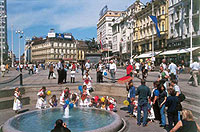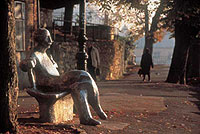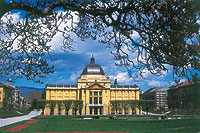| |
Croatia extends from the furthest eastern edges of the Alps in the north-west to the Pannonian lowlands and the banks of the Danube in the east; its central region is covered by the Dinara mountain range, and its southern parts extend to the coast of the Adriatic Sea. The mainland covers 56,542 km2, and the surface of the territorial sea is 31,067 km2. Croatia has 4,437,460 inhabitants, the majority of the population are Croats and national minorities are Serbs, Slovenes, Hungarians, Bosnians, Italians, Czechs and others. Worldwide it is famous by 1,185 islands, solitary rocks and reefs of which only 50 islands are inhabited.. Croatia is indeed unique, not only for its crystal clear, clean blue sea, but also for a thousand years of different cultures that have replaced each other and sometimes assimilated in these areas. There are many historical monuments to be seen all around Croatia, as well as many beautiful towns.
The national currency is kuna (1 EUR - about 7,5 kn) and it can be exchanged in banks, exchange offices, post offices, travel agencies, hotels, camps, marinas; cheques can be cashed in banks.

photo: Zagreb Tourist Board
|
The capital city of the Republic of Croatia - Zagreb is an old Central European city. For centuries it has been a focal point of culture and science, and now of commerce and industry as well. It lies on the intersection of important routes between the Adriatic coast and Central Europe. When the Croatian people achieved their independence in 1991, Zagreb became a capital - a political and administrative centre for the Republic of Croatia. Zagreb is also the hub of the business, academic, cultural, artistic and sporting worlds in Croatia. Many famed scientists, artists and athletes come from the city, or work in it. Zagreb can offer its visitors the baroque atmosphere of the Upper Town, picturesque open-air markets, diverse shopping facilities, an abundant selection of crafts and a choice vernacular cuisine. Zagreb is a city of green parks and walks, with many places to visit in the beautiful surroundings. The city entered into the third millennium with a population of one million. In spite of the rapid development of the economy and transportation, it has retained its charm, and a relaxed feeling that makes it a genuinely humane city.

photo: Zagreb Tourist Board
|
The first written mention of the city dates from 1094, when a diocese was founded on Kaptol, while in 1242, neighbouring Gradec was proclaimed a free and royal city. Both the settlements were surrounded by high walls and towers, remains of which are still preserved.
When Kaptol, Gradec and the surrounding settlements were administratively combined into the integrated city of Zagreb in 1850, the development accelerated still more. The disastrous earthquake of 1880 sparked off the reconstruction and modernisation of many shabby neighbourhoods and buildings. Prestigious public buildings were erected, parks and fountains were made, and transportation and other infrastructures were organised.

photo: Zagreb Tourist Board
|
In the 19th century the population increased tenfold. The twentieth century brought the Secession style to Zagreb. The city lived in the plenty of a civil society, with firm links with all the central European centres. With an increase in wealth and industry from the 1960s on, the city spread out over the wide plains alongside the Sava River, where a new, contemporary business city has developed, ready for the challenges of the third millennium.
 More information about Zagreb on Zagreb Touris Board web page More information about Zagreb on Zagreb Touris Board web page
|